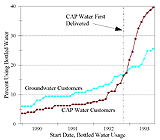
| ch. 2, pp. 12 - 14 |
Many customers receiving CAP water sought to avoid some of these unpleasant effects by buying bottled water or in-home treatment systems, such as filters installed under the sink. Figure 2-10 shows the increase in bottled water usage by Tucson Water customers in response to the introduction of CAP water in November 1992. Purchases of both bottled water and in-home treatment systems have been rising on a national basis for a number of years, and aggressive marketing of bottled water by a growing number of bottled water outlets led to an increase in bottled water usage for all Tucson Water customers over this time period. However, customers switched from groundwater to CAP water increased their bottled water usage more than ten fold, compared to a tripling in the rate of bottled water usage for those kept on groundwater.
Research by the Water Resources Research Center revealed a similar pattern for purchases of in-home water treatment systems, as customers with in-home treatment systems increasing four-fold to nearly 20 percent. The study also documented dramatically higher rates of plumbing and water-using appliances failing in households switched to CAP water. While an accurate estimate of all costs could not be made, the study suggested that Tucson Water customers receiving CAP water were incurring many millions of dollars of expenses per year to avoid and compensate for the decreased water quality. The City Council debated the possibility of ending direct delivery of CAP water, but in August 1993 twice voted by narrow margins to keep delivering CAP water. In October 1993, deliveries were halted to the east side of the CAP delivery area, which generally had a high number of older galvanized steel water mains and was most heavily affected. As more complaints were reported, Tucson Water responded by adding a corrosion inhibitor to the water as it left the treatment plant. However, maintaining effective corrosion inhibitor levels throughout the distribution system proved difficult. The utility also began frequently adjusting the chemistry of the water in an effort to control the problems. Several different levels of pH adjustment were tried for varying lengths of time. These frequent changes in pH level were later identified as probably contributing to the problem rather than correcting it. The City of Tucson also set up a program to handle damage claims. While not admitting fault or responsibility for damages, the City offered to pay up to specified amounts to reimburse for specific types of damage. As of 1995, the City had paid over $1 million dollars in damage claims, and has since added to this amount. Public exasperation with the delivery problems grew as damage to homes mounted and the extent of the problem became apparent. In May 1994, voters surprised some observers by approving $31 million in bonds for improvement of the water delivery system, mostly to replace old galvanized steel or iron water mains. All CAP water deliveries had to be halted in November 1994 to allow for repairs to siphons in the CAP system, and City Council voted not to resume deliveries. By this time, the head of Tucson Water and the CAP plant manager had resigned, and the utility’s reputation had been seriously damaged in the eyes of many citizens. Petitions were circulated for a ballot issue to limit future direct delivery and in November 1995, voters approved the Water Consumer Protection Act (WCPA), which outlawed direct use of CAP water unless it was treated to the quality of Avra Valley groundwater and was free of disinfection by-products (See chapter 7). The WCPA had the effect of shifting the focus for how to use CAP water in Tucson to artificial recharge. In 1997, voters reaffirmed their opposition to direct use of CAP water in favor of its recharge and use by farms and industry, by defeating a ballot initiative which would have repealed or substantially changed many of the provisions of the WCPA. Some citizens also joined a class-action lawsuit against the City. Resolution of this litigation is pending. Tucson Water now has four major wellfields — Southside, Santa Cruz, Central and Avra Valley — along with a large number of wells scattered throughout the city, and a few small isolated systems in remote areas. In addition, more than 30 water companies operate well systems in the Tucson area. The largest of these are Metropolitan Domestic Water Improvement District, Oro Valley Water Department and Flowing Wells Irrigation District. Other significant water pumpers include the University of Arizona, Davis-Monthan Air Force Base, Cortaro Marana Irrigation District, Farmers’ Investment Company (FICO), Farmers’ Water Company and the ASARCO Mining Co. Finally, approximately 22,000 individuals and businesses have their own wells. No one agency coordinates or regulates the activities, of all these users; instead, the Arizona Department of Water Resources (ADWR), the Arizona Corporation Commission (ACC), the Arizona Department of Environmental Quality (ADEQ), the Central Arizona Water Conservation District (CAWCD), the U.S. Environmental Protection Agency (EPA) and the courts all have roles in managing water supply, water quality and water rates. (See Chapter 7 for additional information on regulatory agencies.)People have been irrigating fields in the Tucson area for at least 2,000 years. Before the Spaniards arrived, most crops were grown in the summer, taking advantage of monsoon rains. The Spaniards introduced winter crops that needed irrigation. They also introduced cattle and horses, animals that affected water supplies as well as vegetation near the streams. The first Anglo farmers continued in the Spanish pattern, with cooperative irrigation systems run by an irrigation master responsible for fairly distributing water. In 1886, the Arizona Mining Index described Tucson farming: “Eight streams of water run through the Santa Cruz Valley opposite Tucson. Five of these ditches are 7-feet wide that now contain a foot and a half of running water. The other three are narrower and contain less.” John Davidson started to build a canal to irrigate 3,500 acres, but the floods of 1887 washed it out before it was finished.
|

